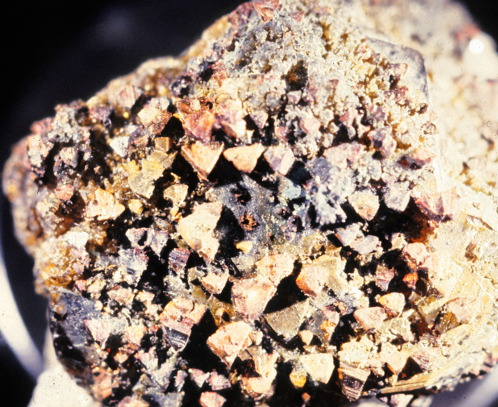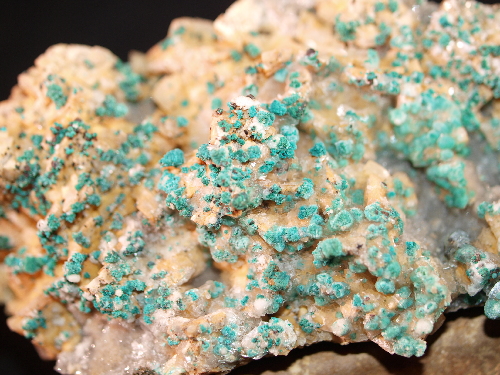Copper
Copper (Cu), called the red metal, was one of the first metals used by man. This is because it is often present in nature as a native element (and therefore is easy to recognize) and because of unique properties which make it readily workable by primitive techniques. Copper is a soft metal with a relatively high specific gravity (8.9), and is highly ductile and malleable. Modern uses of copper are quite numerous, including electrical wiring, as a necessary metal in the alloys of brass, bronze, and nickel silver, self-lubricating bearings (copper powder), copper tubing, coinage, and copper sulfate (CuSO4), a compound which has many chemical applications. Copper sulfate usage in agriculture to prevent the growth of algae and fungi and as a source of essential trace copper in fertilizer and animal feeds has steadily increased over the years.

Copper

Oriented chalcopyrite on sphalerite

Malachite
Copper is present in at least 19 minerals known in Arkansas. Most of these minerals are fairly scarce, but chalcopyrite (CuFeS2), malachite (Cu22+(CO3)(OH)), and native copper (Cu) are common enough to have encouraged some exploration. Copper mineralization is often present as a minor accessory mineral associated with lead and zinc deposits of the Ozark Plateaus and Ouachita Mountains. In the Ozarks, copper minerals, often associated with sphalerite ((Zn,Fe)S), are most frequently found near faults, flexures, and other structural irregularities in Paleozoic limestones and dolostones. In the Ouachita Mountains, small deposits of copper minerals are found in some quartz veins, usually in association with lead, zinc, or antimony mineralization.
All known deposits of copper minerals in Arkansas are small and uneconomic. In 1900, a small amount of copper was refined from malachite-bearing ore recovered from surface residuum at the Tomahawk mine in Searcy County. An occurrence of secondary copper minerals in Fulton County is sub-economic. Copper minerals associated with lead and zinc mineralization have not proven sufficiently abundant to develop, although the potential exists that copper could be recovered as a by-product from other mining activity.
References
McKnight, E. T., 1935, Zinc and lead deposits of northern Arkansas: U. S. Geological Survey Bulletin 853, 311 p.
Miser, H. D., and Purdue, A. H., 1929, Geology of the DeQueen and Caddo Gap quadrangles, Arkansas: U. S. Geological Survey Bulletin 808, 195 p.
Image courtesy of Spinningspark from https://commons.wikimedia.org/wiki/File:NatCopper.jpg